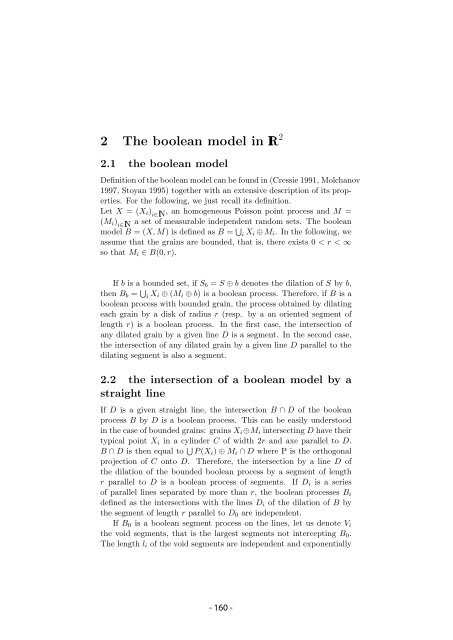Ecole Nationale Supérieure Agronomique de Montpellier ... - CIAM
Ecole Nationale Supérieure Agronomique de Montpellier ... - CIAM
Ecole Nationale Supérieure Agronomique de Montpellier ... - CIAM
Create successful ePaper yourself
Turn your PDF publications into a flip-book with our unique Google optimized e-Paper software.
2 The boolean mo<strong>de</strong>l in IR 2<br />
2.1 the boolean mo<strong>de</strong>l<br />
Definition of the boolean mo<strong>de</strong>l can be found in (Cressie 1991, Molchanov<br />
1997, Stoyan 1995) together with an extensive <strong>de</strong>scription of its properties.<br />
For the following, we just recall its <strong>de</strong>finition.<br />
Let X = (Xi) i∈IN , an homogeneous Poisson point process and M =<br />
(Mi) i∈IN a set of measurable in<strong>de</strong>pen<strong>de</strong>nt random sets. The boolean<br />
mo<strong>de</strong>l B = (X, M) is <strong>de</strong>fined as B = <br />
i Xi ⊕ Mi. In the following, we<br />
assume that the grains are boun<strong>de</strong>d, that is, there exists 0 < r < ∞<br />
so that Mi ∈ B(0, r).<br />
If b is a boun<strong>de</strong>d set, if Sb = S ⊕ b <strong>de</strong>notes the dilation of S by b,<br />
then Bb = <br />
i Xi ⊕ (Mi ⊕ b) is a boolean process. Therefore, if B is a<br />
boolean process with boun<strong>de</strong>d grain, the process obtained by dilating<br />
each grain by a disk of radius r (resp. by a an oriented segment of<br />
length r) is a boolean process. In the first case, the intersection of<br />
any dilated grain by a given line D is a segment. In the second case,<br />
the intersection of any dilated grain by a given line D parallel to the<br />
dilating segment is also a segment.<br />
2.2 the intersection of a boolean mo<strong>de</strong>l by a<br />
straight line<br />
If D is a given straight line, the intersection B ∩ D of the boolean<br />
process B by D is a boolean process. This can be easily un<strong>de</strong>rstood<br />
in the case of boun<strong>de</strong>d grains: grains Xi⊕Mi intersecting D have their<br />
typical point Xi in a cylin<strong>de</strong>r C of width 2r and axe parallel to D.<br />
B ∩ D is then equal to P (Xi) ⊕ Mi ∩ D where P is the orthogonal<br />
projection of C onto D. Therefore, the intersection by a line D of<br />
the dilation of the boun<strong>de</strong>d boolean process by a segment of length<br />
r parallel to D is a boolean process of segments. If Di is a series<br />
of parallel lines separated by more than r, the boolean processes Bi<br />
<strong>de</strong>fined as the intersections with the lines Di of the dilation of B by<br />
the segment of length r parallel to D0 are in<strong>de</strong>pen<strong>de</strong>nt.<br />
If B0 is a boolean segment process on the lines, let us <strong>de</strong>note Vi<br />
the void segments, that is the largest segments not intercepting B0.<br />
The length li of the void segments are in<strong>de</strong>pen<strong>de</strong>nt and exponentially



